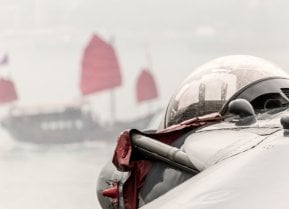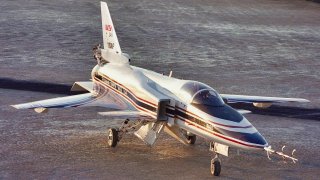X-29: The 'Backwards Looking' Fighter Built for a Russia Fight (Only 2 Built)
Northrop Grumman’s X-29, an experimental fighter jet from the Cold War era, remains a favorite among aviation enthusiasts despite never advancing beyond the testing phase.
Summary and Key Points: Northrop Grumman’s X-29, an experimental fighter jet from the Cold War era, remains a favorite among aviation enthusiasts despite never advancing beyond the testing phase.
-Developed in the 1980s to challenge Soviet air superiority, the X-29 featured revolutionary forward-swept wings, offering exceptional maneuverability and supersonic capabilities.
-Powered by a General Electric F404-GE-400 engine, the X-29 reached speeds of Mach 1.6 and flew 242 missions between 1984 and 1991. However, like its Russian counterpart, the Su-47, the X-29 faced significant design challenges and was ultimately retired, with only two prototypes ever built.
The X-29: Northrop Grumman’s Experimental Fighter with Forward-Swept Wings
Manufacturer Northrop Grumman may be best known for developing the F-14 fighter popularized by the blockbuster film Top Gun, however, the company is behind one of the most obscure experimental airframes in aviation history. In fact, the X-29 never even made it past its testing phase. This airframe was developed more than four decades ago, yet it remains a fan favorite for aviation experts.
An overview of the X-29’s history
When the Cold War was heating up back in the 1970s, the U.S. military began seeking a dynamic fighter platform to better compete against the Soviet’s own aerial fleet.
The X-29 was submitted to fulfill this need, going up against the General Dynamics F-16 Fighting Falcon. When this prototype was introduced, it became the first airframe of its kind to feature forward-swept wings that made it appear as though they were installed backward.
Incorporating this unique feature was new. However, the concept driving it dated back further. Both the U.S. and Nazi Germany experimented with forward-swept wings during the Second World War. Like design issued that would persist to plague the X-29, these earlier conceptions were also flawed.
The X-29 notably achieved the ability to fly supersonically with this unique wing design.
As detailed by NASA – “The complex geometries of the wings and canards combined to provide exceptional maneuverability, supersonic performance, and a light structure. Air moving over the forward-swept wings tended to flow inward toward the root of the wing instead of outward toward the wing tip as occurs on an aft-swept wing. This reverse airflow kept the wing tips and their ailerons from stalling at high angles of attack (direction of the fuselage relative to the airflow).”
NASA and the Defense Advanced Research Projects Agency collaborated to make sure the wing design functioned on the X-29. Advanced composite materials enabled the wing structures to be lightweight and rigid. While the X-29 was very agile even flying at fast speeds, it required a computerized fly-by-wire control system for stability.
More specs and capabilities:
The X-29 measured roughly 48 feet long and its unique wingspan stretched to just over 27 feet.
The fighter was powered by the General Electric F404-GE-400 engine, which produced 16,000 pounds of thrust.
Additional details surrounding the X-29’s specs were outlined by NASA:
“The aircraft had a maximum operating altitude of 50,000 feet, a maximum speed of Mach 1.6 and a flight endurance time of approximately one hour. The only significant difference between the two aircraft was an emergency spin chute deployment system mounted at the base of the rudder on aircraft No. 2. External wing structure is primarily composite materials incorporated into precise patterns to develop strength and avoid structural divergence. The wing substructure and the basic airframe itself are aluminum and titanium. Wing trailing edge actuators controlling camber are mounted externally in streamlined fairings because of the thinness of the supercritical airfoil.”
In the mid-1980s, the X-29 took its first flight from Edwards Air Force Base. Northrop Grumman’s Chief Test Pilot Chuck Sewell flew the airframe.
A second X-29 prototype flew two years later. In total, both aircraft were in the air 242 times between 1984 and 1991. The first X-29 to fly was relegated to display duties at the Research and Development Gallery of the National Museum of the U.S. Air Force on Wright-Patterson Air Force Base in Ohio.
The Second airframe found its way back to the Armstrong Flight Research Center on Edwards Air Force Base.
What about Russia's "copycat" X-29 fighter?
Roughly five years after the X-29s flew on their final missions, Russia debuted its own version of a fighter jet with forward-swept wings. This copy-cat airframe was designated the Sukhoi Su-47.
Like its American counterpart, the Soviet fighter has many issues. Without munitions, the Su-47 weighed a whopping 18 tons. This added pressure on its wings, which were already over-worked when flying high-speed movements. Two D-30F-11 turbojet engines powered the Soviet fighter, enabling the aircraft to fly at speeds of Mach 1.65, comparably slower than the U.S. X-29.
Ultimately, the experimental plane was nixed, and only one was ever built.
About the Author: Maya Carlin
Maya Carlin is an analyst with the Center for Security Policy and a former Anna Sobol Levy Fellow at IDC Herzliya in Israel. She has by-lines in many publications, including The National Interest, Jerusalem Post, and Times of Israel. You can follow her on Twitter: @MayaCarlin.
All images are Creative Commons.


